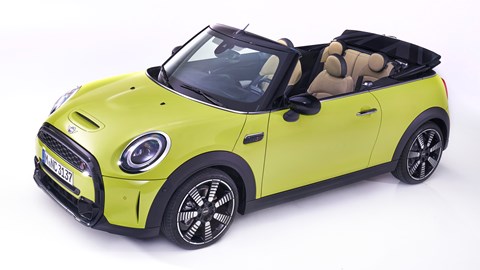► Striking new looks for dinkiest Mini
► Technology and kit upgrades, too
► Order books open now, from £16k
Less is more, so they say, a theme that’s very much front and centre of mind for the latest makeover for the miniest of Minis.
Nothing unusual about that given the third-generation Mini Hatch and Convertible are going to be showroom staples until 2023, so a freshen-up is a sensible lifecycle extension strategy.
Unfortunately, in this quest for unadorned modernity, some of that quintessential Mininess has been diluted.
Okay, walk me through the changes
Remember the Mini’s last revamp? Minor titivation, with personalised name badges and whimsical Union Flag tail lamps dialled-up its inherent charm.

Cutesy, chromed curves have given way to more chiselled, aero-efficient planes that appear more generically Teutonic in their application.
Most obviously different at the front is the revised bumper assembly that slots into the unchanged metalwork, Grille openings are both smaller and plainer, with a body-coloured panel dominating the centre, replacing the gloss black moulding installed previously.
Combined with larger single frame for the combined grilles, if one is being unkind, this pursuit of reduction has conspired to make the Mini resemble a dismayed grouper fish. More charitably, it has a similar vibe to those last-gasp facelifted Rovers of 2004… On second thoughts, stick with the aquatic analogy.

Elsewhere, the front DRL-cum-foglight-cum-cornering light modules have given way to wind-shaping slots on the outer extremes of the bumpers, while the innards of the headlights are now black rather than silver. They can also be specified with adaptive matrix LEDs at extra cost.
Side indicators and the central rear foglamp also now employ a slither of LEDs for their illumination.
Is that it for the outside?
Yes, pretty much, aside from an assortment of new alloys and a refreshed colour palette, the biggest departure is the optional Multitone Roof, available on the Hatch for more of your hard-earned.

Using a technique dubbed Spray Tech, where different coloured paints are sprayed on before the preceding layer has dried, unique blends between the hues are created.
Starting with San Marino Blue above the windscreen, the central portion is Pearly Aqua culminating in Jet Black as it approaches the rear roof spoiler. We’ll reserve judgement until we see it in the metal.
More of the same inside
Yet more of the irreverence many associate with Minis has been eroded inside as screens and glossy black switchgear are the order of the day.
Gone is the analogue instrument pod mounted on top of the steering column replaced by a slicker, horizontal 5-inch screen similar to that already seen in the Mini Electric and John Cooper Works GP3. It’s all a far cry from the dustbin lid central speedo of yesteryear.

Flanking the revised central multimedia display with its box-fresh operating system, spangly graphics and new buttons are a pair of revised airvents, while the ambient LED lighting is further complemented by Lounge (blue) and Sport (red and black) modes for the display screens.
Standard equipment across the Classic, Sport and Exclusive grade structure is also enhanced, plus there’s a limited run of 300 special Mini Electrics called Collection that features the Multitone Roof, black exterior mouldings and special graphics.
Will the 2021 Mini feel any different to drive?
Possibly, but we’ll know for sure in a few weeks when we get our hands on one of the revised models.

Sport versions now come with a revised version of the adaptive damper system, claimed to deliver a less compromised balance between the poles of ride comfort and go-kart handling.
Driver aids are further bolstered with the arrival of additional elements within the optional Driver Assistance Pack. New to the smallest Minis, rather than new technology full stop, are a lane-departure warning system that vibrates the wheel when you wander and an adaptive cruise control arrangement that will take automatic versions to a complete standstill until it’s free to proceed again.

Powertrains are essentially as before in terms of petrol triples and fours, plus the Electric three-door Hatch, all being Euro 6d-compliant for emissions. Diesels, falling out of favour in many sectors of the market, disappeared in the latter half of 2020.
If you were awaiting more concrete news on the electric JCW, then you’ll have to wait a little longer.
How much is all this going to cost?
Orders for the tweaked Minis can be placed as of now, with the first cars being delivered in spring 2021.
Three-door, petrol-engined Hatch models cost from £16,045 for a Mini One, while the five-door version will set you back an extra £700.

Convertibles, which start at Cooper specification, start at £20,705, while the Mini Electric commands a £27,920 price for a Level 1. That special edition Electric Collection is £36,420, and yes, that noise was us collectively sucking air in through our teeth.
While it should remain one of the most engaging small cars to drive, its new sober appearance visually hints at a change of ethos for the brand, one where out-and-out fun is less important. We hope to be proved wrong.
Read our Mini reviews
